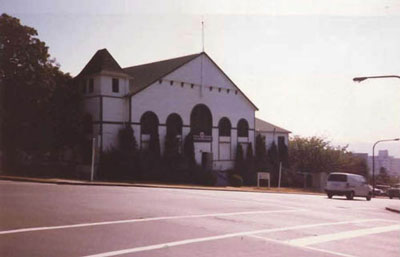Armoury
Recognized Federal Heritage Building
New Westminster, British Columbia

Side view
© (Department of National Defense / ministère de la Défense nationale, 1986.)
Address :
530 Queen / 6th Street, New Westminster, British Columbia
Recognition Statute:
Treasury Board Policy on Management of Real Property
Designation Date:
1987-06-18
Dates:
-
1895 to 1895
(Construction)
Event, Person, Organization:
-
Chief Architect’s Branch of the Department of Public Works
(Organization)
Other Name(s):
-
New Westminster Armoury
(Other Name)
Custodian:
National Defence
FHBRO Report Reference:
86-60
DFRP Number:
17008 00
Description of Historic Place
The Armoury in New Westminster is located on a sloping site within a mix of residential, small commercial, and public structures. It is a large, low-massed, rectangular structure with slightly projecting square towers. Large round-headed windows pierce its walls. The white painted, wooden construction conveys an image of sober simplicity. The main facades feature broad troop doors. The designation is confined to the footprint of the building.
Heritage Value
The Armoury is a Recognized Federal Heritage Building because of its historical associations, and its architectural and environmental values.
Historical Value:
The Armoury is closely associated with the 19th century volunteer militia movement. It is also associated with the Royal Westminster Regiment, a renowned militia unit, a member of which was awarded the Victoria Cross in 1944.
Architectural Value:
The Armoury is a very good example of a late 19th century armoury. It incorporates details, motifs, elements and shapes that are typical for this time period in west coast buildings. Its exterior exhibits Italianate, Romanesque revival influences. It is unique because armouries at this date were normally composed of brick and it is constructed entirely of wood.
Environmental Value:
The Armoury is compatible with its evolved setting of mixed-use commercial and residential buildings. It plays an important role as a familiar city landmark.
Sources:
Robert Hunter, New Westminster Armoury, 6th Street and Queen’s Avenue, New Westminster, British Columbia. Federal Heritage Buildings Review Office Report 86-060; New Westminster Armoury, 6th Street and Queen’s Avenue, New Westminster, British Columbia. Heritage Character Statement 86-060.
Character-Defining Elements
The character-defining elements of the Armoury should be respected.
Its simple, functional character with Italianate, Romanesque revival influences used for military purposes using good quality materials and craftsmanship, for example: the large, low massing with a gable roof; the long main façade symmetrically flanked by slightly projecting square towers and capped by steeply pitched, bellcast mansard roofs; the round arched windows that pierce the long flat walls at two levels; the regular grouping of the window openings; the spartan interior characterized by its large, open volume and the large cedar tie beams that span the hall.
The manner in which the Armoury is compatible with the adjacent mixed-use commercial and residential buildings and is a familiar community landmark as evidenced by: its large, but low massing which makes it compatible with its neighbouring residential area of late-19th century houses, parkland, and newer mixed use commercial and residential buildings; its distinctive appearance which makes it a familiar landmark in the community.
Heritage Character Statement
Disclaimer -
The heritage character statement was developed by FHBRO to explain the reasons for the designation of a federal heritage building and what it is about the building that makes it significant (the heritage character). It is a key reference document for anyone involved in planning interventions to federal heritage buildings and is used by FHBRO in their review of interventions.
The New Westminster Armoury was built in 1895 by the Department of Public Works for the Department of Militia and Defence. It is now owned by the Department of National Defence. See FHBRO Building Report 86-60.
Reasons for Designation
The New Westminster Armoury was designated a ARecognized@ Federal Heritage Building because of its association with the volunteer militia movement in the 19th century and a renowned militia unit, the Royal Westminster Regiment, a member of which was awarded the Victoria Cross in 1944.
The New Westminster Armoury is most likely the only surviving large armoury built entirely of wood, the construction material traditionally used in the region.
Character Defining Elements
The New Westminster Armoury was constructed entirely of wood and is composed of details, motifs, elements and shapes that are typical of West Coast buildings dating from the late 19th or early 20th century. This building is unique because armouries were normally constructed of stone and brick. The building owes its heritage character to its materials, details, structure and exterior composition.
The primary purpose of an armoury is to provide a large, unobstructed indoor area with associated offices, quartermaster stores and other military facilities. The visible girders, normally made of steel, but in this case of cedar, should be preserved as an essential element of the building=s heritage character.
The exterior of the Armoury is best described by its symmetry and simplicity. Its long, low massing and lack of decoration give it the simple, utilitarian appearance of Edwardian period structures. The impression of austerity is offset by side towers, segment-head windows, slightly projecting gables, and the texture of the wood cladding and shingles. This combination of materials and details should be preserved as an essential element of the building=s character. Identical materials should be used in any future repairs.